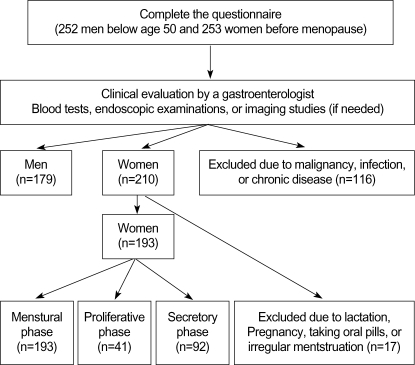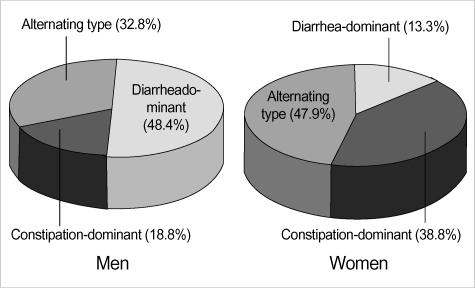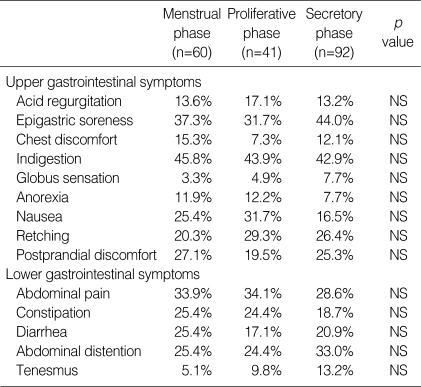Abstract
Functional gastrointestinal disorders are more common in women in relation to the fluctuations of female sex hormones. We tried to know the gender-related differences in the prevalence of irritable bowel syndrome and gastrointestinal symptoms according to the menstrual phase. A total of 253 women before menopause and 252 men below age 50 were examined by a gastroenterologist after completing the questionnaire. Blood tests, endoscopic procedures, and imaging studies were done, if needed. Women were subclassified into three groups according to their menst- ruation period; menstrual phase, proliferative phase, and secretory phase. Finally, 179 men and 193 women were analyzed. Irritable bowel syndrome was more frequently noticed in women than in men (p=0.01). The diarrhea-dominant type was more common in men, while constipation-dominant or alternating types were more common in women (p<0.001). Of 193 women, there was no significant difference in their gastrointestinal symptoms according to their menstrual phase. Regardless of the menstrual phase, gastrointestinal symptoms are more frequent in women. Physicians should consider different symptomatic manifestations between men and women should be considered when evaluating functional gastrointestinal disorders.
Keywords: Gastrointestinal Diseases, Women, Irritable Bowel Syndrome, Menstruation
INTRODUCTION
It is known that functional gastrointestinal disorders are more common in women in relation to the fluctuations of female sex hormones, and previous studies have focused on explaining this gender-related difference due to the higher prevalence of functional dyspepsia (FD) and irritable bowel syndrome (IBS) in women (1, 2). As a cause of gender differences, gastrointestinal transit time, visceral sensitivity, central nervous system pain processing, and specific effects of estrogen and progesterone on gut function were considered as well as psychosocial characteristics, gender-related differences in neuroendocrine, autonomic nervous system, and stress reactivity, which are related to bowel function and pain (2). In addition, it is reported that women with IBS have more bowel symptoms during their menstruation period than women without IBS (3).
Since there is no biological marker for functional gastrointestinal disease, a diagnosis is made by using symptom-based criteria. In the present study, we tried to detect the genderrelated differences in the prevalence of IBS by self-reported symptoms. In addition, we analyzed the symptoms according to their menstrual phase in women, since women are often treated as a homogenous group by menopausal status, menstrual cycle, and use of hormones in gender-related issues.
MATERIALS AND METHODS
Subjects
From October to November 2005, 505 subjects (253 women before menopause and 252 men below age 50) who visited the Digestive Disease Center of Konkuk University Hospital were included in this prospective study. This study was approved by the Institutional Review Board of Konkuk University College of Medicine that the study protocol was in accordance with the ethical guidelines of the Helsinki Declaration revised in 1989.
The subjects were identified by clinical receptionists on arrival and asked to fill out a self-administered questionnaire. Subjects were examined by a gastroenterologist after completing the questionnaire, and were diagnosed according to the Rome-II criteria (4). Further examinations including blood tests, endoscopic procedures, and imaging studies were done, if needed. After the interview and examinations, subjects with malignant disease or acute infection, or those who have chronic disease requiring medications, were excluded from the study.
Questionnaire
Questionnaire was consisted of four categories; (i) questions on demographic factors including age, sex, height, and weight, (ii) questions on menstruation in women, (iii) questions on current medications and current disease such as diabetes, hypertension, urologic disease, anorectal disease, infection, depression, headache, fatigue, myalgia, and dysmenorrhea, and (iv) questions on consisting symptoms of the Rome II criteria for IBS.
Subjects were considered to have IBS if they answered yes to at least two of the following questions for at least 12 weeks, which need not be consecutive during the preceding 12 months; (i) abdominal discomfort or pain relieved with defecation, (ii) onset associated with a change in frequency of stool, and (iii) onset associated with a change in appearance of stool (4). Subjects who met the criteria for IBS were classified into IBS subtypes based on their responses to the following questions; (A) fewer than 3 bowel movements/week, (B) more than 3 bowel movements/day, (C) hard or lumpy stools, (D) loose or watery stools, (E) straining during a bowel movement, (F) urgency, (G) sensation of incomplete bowel movement, (H) passing mucus, and (I) abdominal fullness, bloating, or swelling (3). Diarrhea-predominant subjects were defined as those who reported at least one of B, D or F, but none of A, C or E. Constipation-predominant subjects were defined as those who reported at least one of A, C or E, but none of B, D or F (4). Those who reported both outcomes were defined as alternators.
Data collection
Responses were collected, transcribed, and analyzed for raw data associations by a reviewer who was unaware of the subjects. Women were subclassified into three groups according to their menstruation periods; menstrual phase (day 0-6), proliferative phase (day 7-14), and secretory phase (after day 15). Women under lactation or pregnancy, taking oral pills, or with an irregular menstrual period more than 36 days were excluded from the study. Finally, 179 men and 193 women (60 menstrual phase, 41 proliferative phase, and 92 secretory phase) were analyzed (Fig. 1).
Fig. 1.
Subjects included in the study. Women were subclassified into three groups according to their menstruation; menstrual phase (day 0-6), proliferative phase (day 7-14), and secretory phase (after day 15).
Statistical analysis
In order to compare differences, the data were analyzed using chi-square test and Student's t-test. For age, results were expressed as mean±SD (standard deviation). A p value less than 0.05 was considered statistically significant.
RESULTS
Subjects diagnosed with IBS
Of 253 women and 252 men, 50.8% of women were diagnosed as IBS, while 35.8% of men were diagnosed as IBS (p=0.01). With aspect to the IBS subtypes, the diarrhea-dominant type was more common in men, while constipationdominant or alternating types were more common in women (p<0.001) (Fig. 2).
Fig. 2.
Difference in the prevalence of subtypes of irritable bowel syndrome between men and women. The diarrheadominant type was more common in men while, constipation-dominant or alternating types were more common in women (p<0.001).
Gastrointestinal symptoms according to the menstrual phase
Of 193 women, there was no significant difference in the prevalence of both upper and lower gastrointestinal symptoms between women in menstrual phase, secretory phase, or proliferative phase. Details are summarized in Table 1.
Table 1.
Prevalence of gastrointestinal symptoms in women with different menstrual phase
NS, not significant.
DISCUSSION
Women are known to have more functional pain syndromes such as fibromyalgia, chronic fatigue syndrome, interstitial cystitis, temporomandibular joint disorder, and migraine headaches when compared to men (5). Although our study was a single center, self-accessed questionnaire-based study, the results revealed that women are more likely to meet the criteria of IBS than men. Our results differ from those of a previous Korean study that reported that the prevalence of IBS in the Korean population is 6.6% and that the male-to-female ratio is similar (6). Several studies have reported that the higher prevalence in women is related with biobehavioral stress response, sex-related differences in autonomic and antinociceptive responses to certain visceral stimuli, gender role, hormonal factors, and psychological symptoms (2, 7-9). The increased prevalence of IBS in women may be related to psychosocial factors rather than differences in colonic motor function (10) because there is no gender differences in visceral perception (11).
Regarding the IBS subtypes, our results revealed that the diarrhea-dominant type was more common in men, while constipation-dominant type was more common in women. Our finding is consistent with previous studies that women have more symptoms of non-pain related gastrointestinal symptoms such as nausea, constipation, and bloating, whereas men report more diarrhea (12, 13). Several psysiological factors may play a role in these gender-related differences in self-reported bowel habits, including differences in central autonomic control, in enteric nervous system physiology, and smooth muscle physiology (14). Although a Korean study demonstrated that female IBS patients did not have enhanced colorectal perception than male IBS patients (11), another Korean study reported that prevalence of self-reported constipation and IBS-C are higher in females than in males (15). This gender differences in bowel habit might be a product of reporting bias, with women being more comfortable in reporting constipation-related symptoms. The relationship between IBS and women was thought to be important because (i) there is a predominance of women as compared to men who seek health care services for IBS, (ii) menstrual cycle-linked differences are observed in IBS symptom reports, (iii) women with IBS tend to report greater problems with constipation and nongastrointestinal complaints associated with IBS, and (iv) serotonin (5-HT3) receptor antagonist and 5-HT4 partial antagonist drugs appear to more effectively diminish reports of bowel pattern disruption in women with IBS as compared to men (16).
In contrast to the previous studies that emphasized greater gastrointestinal symptoms during menstruation (3, 17, 18), our results revealed that menstrual phase did not affect the gastrointestinal symptoms directly. This discrepancy might be due to the selection bias in our study material, since all subjects were those who visited the Digestive Disease Center due to various gastrointestinal symptoms. However, etiologies other than female sex hormone should be considered for gastrointestinal symptoms, since there was no relationship between the menstrual phase and the prevalence of each gastrointestinal symptoms. Although most studies have reported on increased bowel symptoms on menstruation (19-21), some reported no differences across the phases of menstrual cycle indicating that estrogen and progesterone levels are not directly related with bowel function (22-25). In addition, a study reported that few symptomatic differences were found between pre- and postmenopausal women, making it unlikely that most of the gender differences observed are directly tied to the menstrual cycle (14).
In conclusion, gastrointestinal symptoms are more frequent in women than in men regardless of the menstrual phase. Therefore, physicians should consider a gender-based approach in clinical practice. In addition, different symptomatic manifestations between men and women should be considered when evaluating IBS.
Footnotes
This study was supported by Konkuk University in 2005.
References
- 1.Mayer EA, Naliboff B, Lee O, Munakata J, Chang L. Review article: gender-related differences in functional gastrointestinal disorders. Aliment Pharmacol Ther. 1999;13(Suppl 2):65–69. doi: 10.1046/j.1365-2036.1999.00008.x. [DOI] [PubMed] [Google Scholar]
- 2.Chang L, Heitkemper MM. Gender differences in irritable bowel syndrome. Gastroenterology. 2002;123:1686–1701. doi: 10.1053/gast.2002.36603. [DOI] [PubMed] [Google Scholar]
- 3.Cho YK, Jung SA, Shim KN, Choi YJ, Kim HS, Lee JS, Kim SE, Kim DY, Yoo K. Relationship between bowel symptom changes and dysmenorrheal in irritable bowel syndrome in women. Korean J Gastrointest Motil. 2003;9:47–52. [Google Scholar]
- 4.Drossman DA, Corazziari E, Talley NJ, editors. ROME II. The Functional Gastrointestinal Disorders. Diagnosis, Pathophysiology and Treatment: A Multinational Consensus. 2nd edn. McLean, VA, USA: Degnon Associates; 2000. Functional bowel disorders and functional abdominal pain. [Google Scholar]
- 5.Triadafilopoulos G, Simms RW, Goldenberg DL. Bowel dysfunction in fibromyalgia syndrome. Dig Dis Sci. 1991;36:59–64. doi: 10.1007/BF01300088. [DOI] [PubMed] [Google Scholar]
- 6.Han SH, Lee OY, Bae SC, Lee SH, Chang YK, Yang SY, Yoon BC, Choi HS, Hahm JS, Lee MH, Lee DH, Kim TH. Prevalence of irritable bowel syndrome in Korea: population-based survey using the Rome II criteria. J Gastroenterol Hepatol. 2006;21:1687–1692. doi: 10.1111/j.1440-1746.2006.04269.x. [DOI] [PubMed] [Google Scholar]
- 7.Taylor SE, Klein LC, Lewis BP, Gruenewald TL, Gurung RA, Updegraff JA. Biobehavioral responses to stress in females: tend-and-befriend, not fight-or-flight. Psychol Rev. 2000;107:411–429. doi: 10.1037/0033-295x.107.3.411. [DOI] [PubMed] [Google Scholar]
- 8.Mayer EA, Berman S, Chang L, Naliboff BD. Sex-based differences in gastrointestinal pain. Eur J Pain. 2004;8:451–463. doi: 10.1016/j.ejpain.2004.01.006. [DOI] [PubMed] [Google Scholar]
- 9.Toner BB, Akman D. Gender role and irritable bowel syndrome: literature review and hypothesis. Am J Gastroenterol. 2000;95:11–16. doi: 10.1111/j.1572-0241.2000.01698.x. [DOI] [PubMed] [Google Scholar]
- 10.Soffer EE, Kongara K, Achkar JP, Gannon J. Colonic motor function in humans is not affected by gender. Dig Dis Sci. 2000;45:1281–1284. doi: 10.1023/a:1005535432163. [DOI] [PubMed] [Google Scholar]
- 11.Kim HS, Rhee PL, Park J, Lee JH, Kim YH, Kim JJ, Rhee JC. Gender-related differences in visceral perception in health and irritable bowel syndrome. J Gastroenterol Hepatol. 2006;21:468–473. doi: 10.1111/j.1440-1746.2005.04060.x. [DOI] [PubMed] [Google Scholar]
- 12.Talley NJ, Boyce P, Jones M. Identification of distinct upper and lower gastrointestinal symptom groupings in an urban population. Gut. 1998;42:690–695. doi: 10.1136/gut.42.5.690. [DOI] [PMC free article] [PubMed] [Google Scholar]
- 13.Corney RH, Stanton R. Physical symptom severity, psychological and social dysfunction in a series of outpatients with irritable bowel syndrome. J Psychosom Res. 1990;34:483–491. doi: 10.1016/0022-3999(90)90022-v. [DOI] [PubMed] [Google Scholar]
- 14.Lee OY, Mayer EA, Schmulson M, Chang L, Naliboff B. Gender-related differences in IBS symptoms. Am J Gastroenterol. 2001;96:2184–2193. doi: 10.1111/j.1572-0241.2001.03961.x. [DOI] [PubMed] [Google Scholar]
- 15.Jun DW, Park HY, Lee OY, Lee HL, Yoon BC, Choi HS, Hahm JS, Lee MH, Lee DH, Kee CS. A population-based study on bowel habits in a Korean community: prevalence of functional constipation and self-reported constipation. Dig Dis Sci. 2006;51:1471–1477. doi: 10.1007/s10620-006-9087-3. [DOI] [PubMed] [Google Scholar]
- 16.Heitkemper M, Jarrett M, Bond EF, Chang L. Impact of sex and gender on irritable bowel syndrome. Biol Res Nurs. 2003;5:56–65. doi: 10.1177/1099800403005001006. [DOI] [PubMed] [Google Scholar]
- 17.Heitkemper MM, Jarrett M. Pattern of gastrointestinal and somatic symptoms across the menstrual cycle. Gastroenterology. 1992;102:505–513. doi: 10.1016/0016-5085(92)90097-i. [DOI] [PubMed] [Google Scholar]
- 18.Whitehead WE, Cheskin LJ, Heller BR, Robinson JC, Crowell MD, Benjamin C, Schuster MM. Evidence for exacerbation of irritable bowel syndrome during menses. Gastroenterology. 1990;98:1485–1489. doi: 10.1016/0016-5085(90)91079-l. [DOI] [PubMed] [Google Scholar]
- 19.Heitkemper M, Jarrett M, Cain K, Shaver J, Bond E, Woods NF, Walker E. Increased urine catecholamines and cortisol in women with irritable bowel syndrome. Am J Gastroenterol. 1996;91:906–913. [PubMed] [Google Scholar]
- 20.Houghton LA, Lea R, Jackson N, Whorwell PJ. The menstrual cycle affects rectal sensitivity in patients with irritable bowel syndrome but not healthy volunteers. Gut. 2002;50:471–474. doi: 10.1136/gut.50.4.471. [DOI] [PMC free article] [PubMed] [Google Scholar]
- 21.Wald A, Van Thiel DH, Hoechstetter L, Gavaler JS, Egler KM, Verm R, Scott L, Lester R. Gastrointestinal transit: the effect of the menstrual cycle. Gastroenterology. 1981;80:1497–1500. [PubMed] [Google Scholar]
- 22.Hinds JP, Stoney B, Wald A. Does gender or the menstrual cycle affect colonic transit? Am J Gastroenterol. 1989;84:123–126. [PubMed] [Google Scholar]
- 23.Jackson NA, Houghton LA, Whorwell PJ, Currer B. Does the menstrual cycle affect anorectal physiology? Dig Dis Sci. 1994;39:2607–2611. doi: 10.1007/BF02087697. [DOI] [PubMed] [Google Scholar]
- 24.Kamm MA, Farthing MJ, Lennard-Jones JE. Bowel function and transit rate during the menstrual cycle. Gut. 1989;30:605–608. doi: 10.1136/gut.30.5.605. [DOI] [PMC free article] [PubMed] [Google Scholar]
- 25.Caballero-Plasencia AM, Valenzuela-Barranco M, Martin-Ruiz JL, Herrerias-Gutierrez JM, Esteban-Carretero JM. Are there changes in gastric emptying during the menstrual cycle? Scand J Gastroenterol. 1999;34:772–776. doi: 10.1080/003655299750025697. [DOI] [PubMed] [Google Scholar]





